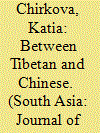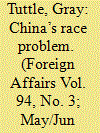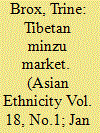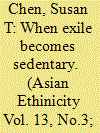|
|
|
Sort Order |
|
|
|
Items / Page
|
|
|
|
|
|
|
| Srl | Item |
| 1 |
ID:
080565


|
|
|
|
|
| Publication |
2007.
|
| Summary/Abstract |
This paper focuses on the ongoing process of changing local ethnic identities in the Southwest of China. The analysis is based on a comparison of two ethnic groups: Xumi and Baimi, both officially classified as Tibetans. While the experienced ethnic identity of the Xumi is in conformity with their official classification, the Baimi feel their own identity as being distinct from the classification imposed by the state. The related changes in local identities are examined with special emphasis on the role played by the Xumi and Baimi languages in creating and assessing group identity. I conclude that for both groups, albeit for various reasons, language is neither the major constructive element of ethnic boundaries nor an exclusive marker of ethnicity, which confirms Haarmaan's 1986 postulation that language is not a necessary criterion of ethnicity.
|
|
|
|
|
|
|
|
|
|
|
|
|
|
|
|
| 2 |
ID:
137529


|
|
|
|
|
| Summary/Abstract |
For all the tremendous change China has experienced in recent decades—phenomenal economic growth, improved living standards, and an ascent to great-power status—the country has made little progress when it comes to the treatment of its ethnic minorities, most of whom live in China’s sparsely populated frontier regions. This is by no means a new problem. Indeed, one of those regions, Tibet, represents one of the “three Ts”—taboo topics that the Chinese government has long forbidden its citizens to discuss openly. (The other two are Taiwan and the Tiananmen Square uprising of 1989.)
|
|
|
|
|
|
|
|
|
|
|
|
|
|
|
|
| 3 |
ID:
078259


|
|
|
|
|
| Publication |
2007.
|
| Summary/Abstract |
Since the Chinese government began implementing economic reforms in the late 1970s, China has undergone profound economic change and growth. However, this growth has not been equitable, and the present economic gap between east and west China is wide. The Tibetans, a minority group in the 'west', are in a particularly dire situation. Although China's strategic policy of developing the west has provided many business opportunities, Tibetans are poorly equipped to respond to and take advantage of these opportunities. The reasons restricting effective market participation are complex and difficult to assess. There are no easy answers. Many political, social, cultural and environmental factors explain the difficulties encountered by Tibetan communities. However, by studying current educational practice with a focus on secondary education in Tibetan areas of China, this paper argues that poor education is among crucial factors explaining the inability of Tibetans to compete economically with non-Tibetan migrants.
|
|
|
|
|
|
|
|
|
|
|
|
|
|
|
|
| 4 |
ID:
086288


|
|
|
|
|
| Publication |
2009.
|
| Summary/Abstract |
Since the Chinese government began implementing economic reforms in the late 1970s, China has undergone profound economic change and growth. Since then, associated policies have provided many business opportunities in Tibetan areas of China, but Tibetans are poorly equipped to respond to and take advantage of these opportunities. The factors restricting effective market participation are complex and difficult to assess. There are no easy answers. Many political, social, cultural and environmental factors explain the difficulties encountered by Tibetan communities. However, this paper argues that relevant economic development policy is among crucial factors explaining the inability of Tibetans to compete with non-Tibetan migrants.
|
|
|
|
|
|
|
|
|
|
|
|
|
|
|
|
| 5 |
ID:
151469


|
|
|
|
|
| Summary/Abstract |
In downtown Chengdu a pocket of Tibetan culture has sprung up: a Tibetan market where Tibetans and Han Chinese meet to buy and sell ethnic minority products. Pointing to how Tibetan migration to Chengdu has contributed to the growth of a vibrant ‘minzu market’ attracting Tibetan and Han Chinese merchants, customers, Buddhist devotees, and voyeurs, this article presents novel understandings of the ethnic goods market in urban Chengdu. The article first explores the growth of the market, which is the result of a history of political and economic reforms, increased mobility, and religious revival. Second, it maps the market infrastructure according to the ethnicity of the shopkeepers and the commodities that are traded. Although there is still a clear ethnic division in the market, this article also documents the emergence of Han Chinese market participation in forms of trade that have historically been dominated by Tibetans.
|
|
|
|
|
|
|
|
|
|
|
|
|
|
|
|
| 6 |
ID:
190307


|
|
|
|
|
| Summary/Abstract |
Academic research focused on Tibetan women-in-exile is rare. Also, very few existing studies explore the perspectives of Tibetan women on the Tibetan nation and their contributions to Tibetan nationalism. Therefore, considering this gap in the literature, this paper explores the question of the Tibetan nation from the perspectives of Tibetan women-in-exile and seeks to understand their contributions to Tibetan nationalism. The paper draws from qualitative interviews conducted with Tibetan women in Dharamsala. The findings indicate that as agents and symbols of nationalism, educated Tibetan women-in-exile express ambivalence in their ideas of Tibetan women’s contributions to Tibetan nationalism. Their narratives help us expand our understanding of Tibetan nationalism and reveal how women as active agents of nationalism contribute to the Tibetan movement. At the same time, the paper argues, the Tibetan women-in-exile have not escaped the symbolism of nationalism attributed to them by the larger Tibetan society.
|
|
|
|
|
|
|
|
|
|
|
|
|
|
|
|
| 7 |
ID:
185974


|
|
|
|
|
| Summary/Abstract |
Karl Polanyi argues that the discipline of economics has emerged from the observations of human beings and their practices existing in a society. Since humans are perceived primarily as social beings rather than economic ones, embeddedness is a necessary and basic condition of the economy. This paper is an attempt to observe study and understand the inter-sectional application of these concepts of embeddedness and ethnic solidarity, in the socio-economic context of the Tibetan refugee community residing in India. Our study’s fieldwork was focused on observing the functioning of the local Tibetan economy in Mcleodganj (Dharamshala), where two Tibetan knowledge systems: the Thangka art and the Tibetan healing system were closely studied, reflecting Tibetan culture, and the community’s effort to preserve and promote these knowledge systems in different economic forms.
|
|
|
|
|
|
|
|
|
|
|
|
|
|
|
|
| 8 |
ID:
112764


|
|
|
|
|
| Publication |
2012.
|
| Summary/Abstract |
Waltraud Kokot and her coauthors stated ' … . despite a necessary focus on transnational networks and movement, ethnographic studies of diaspora must also not neglect the realities of sedentary diasporic life.' Taking such a call as my point of departure, this article explores the quotidian experiences of 'in exile' specific to a subgroup of Tibetans in Dharamsala, north India, who have for a couple of decades at least described themselves as the 'India-born'. Secondly, it particularly attends to the sensory domains of these Tibetans' local/Indian experiences and in turn highlights the geo-affinity that they ambivalently feel for the place where they are at once native and exilic. Demonstrated in the article are the ongoing processes through which individuals, feeling marked by the displacement of the nation to which they belong, realize their Tibetan attributes in the context(s) they in varied ways perceive as 'Indian'.
|
|
|
|
|
|
|
|
|
|
|
|
|
|
|
|
|
|
|
|
|